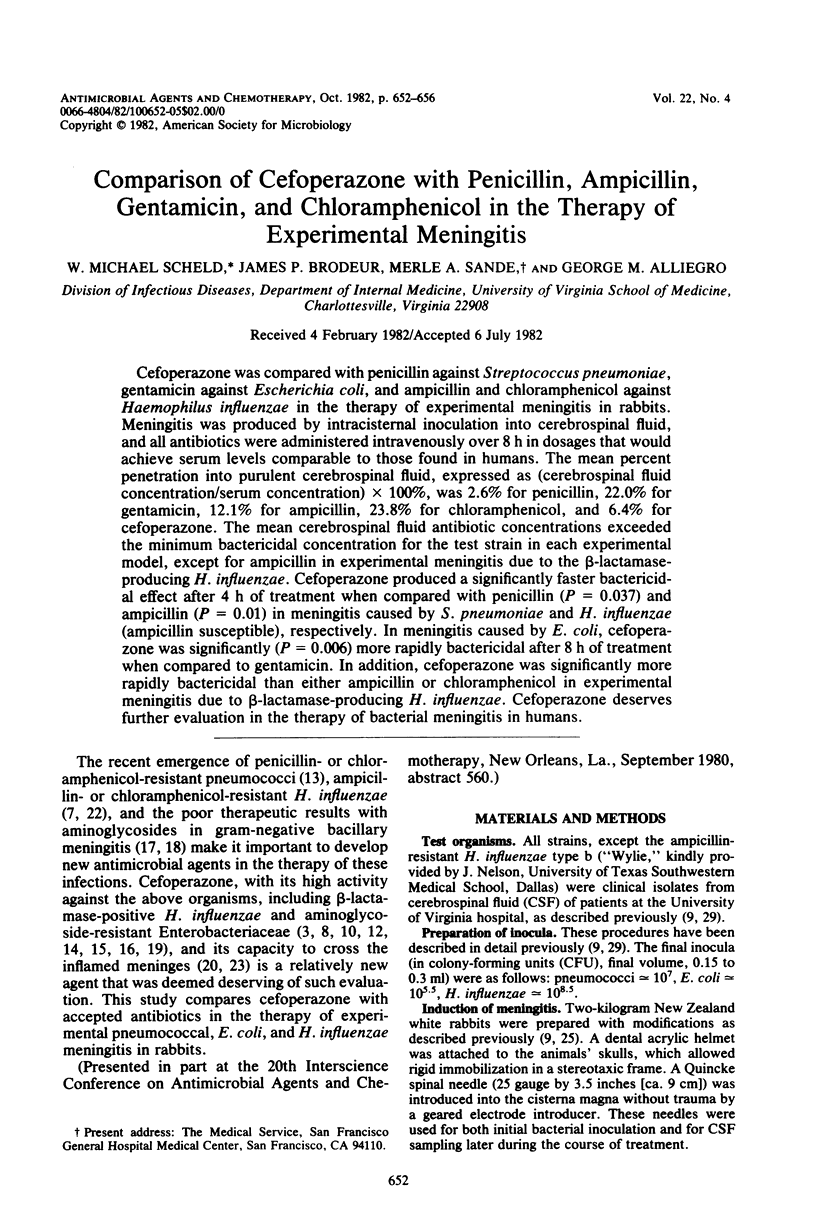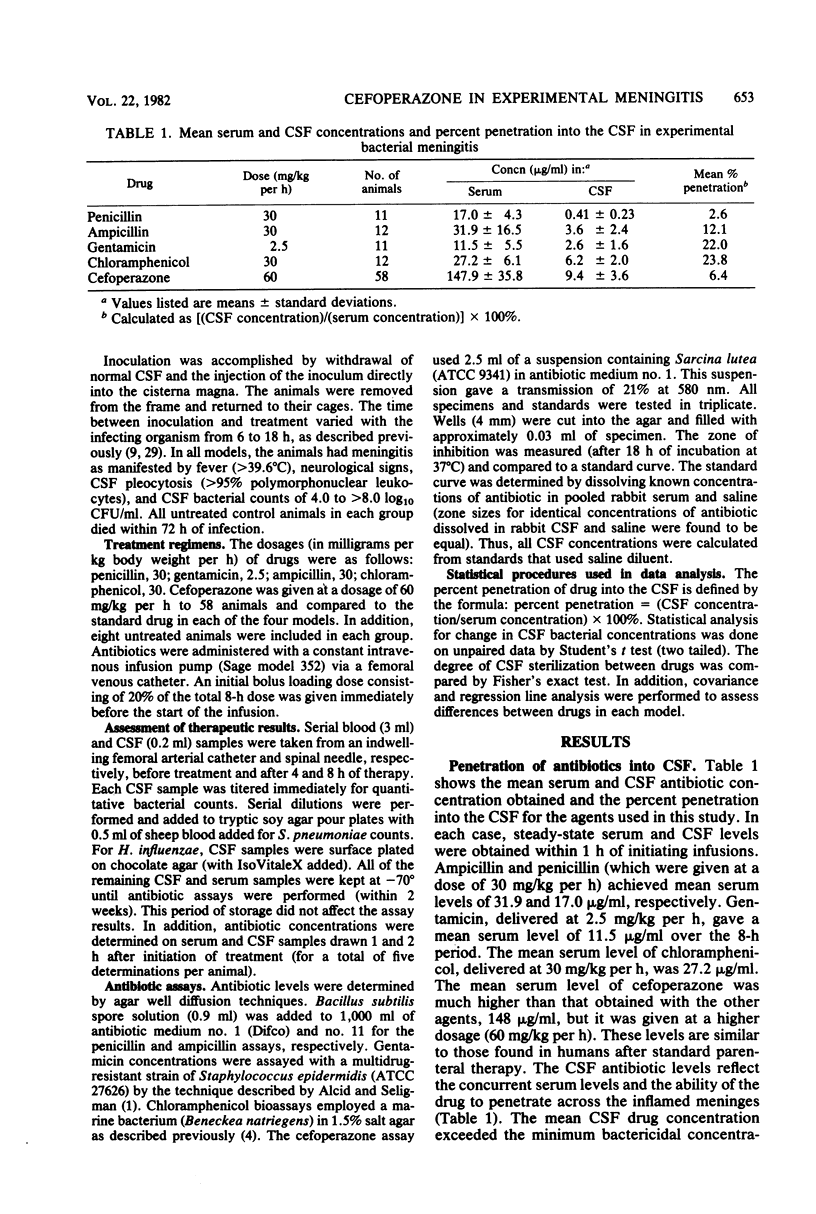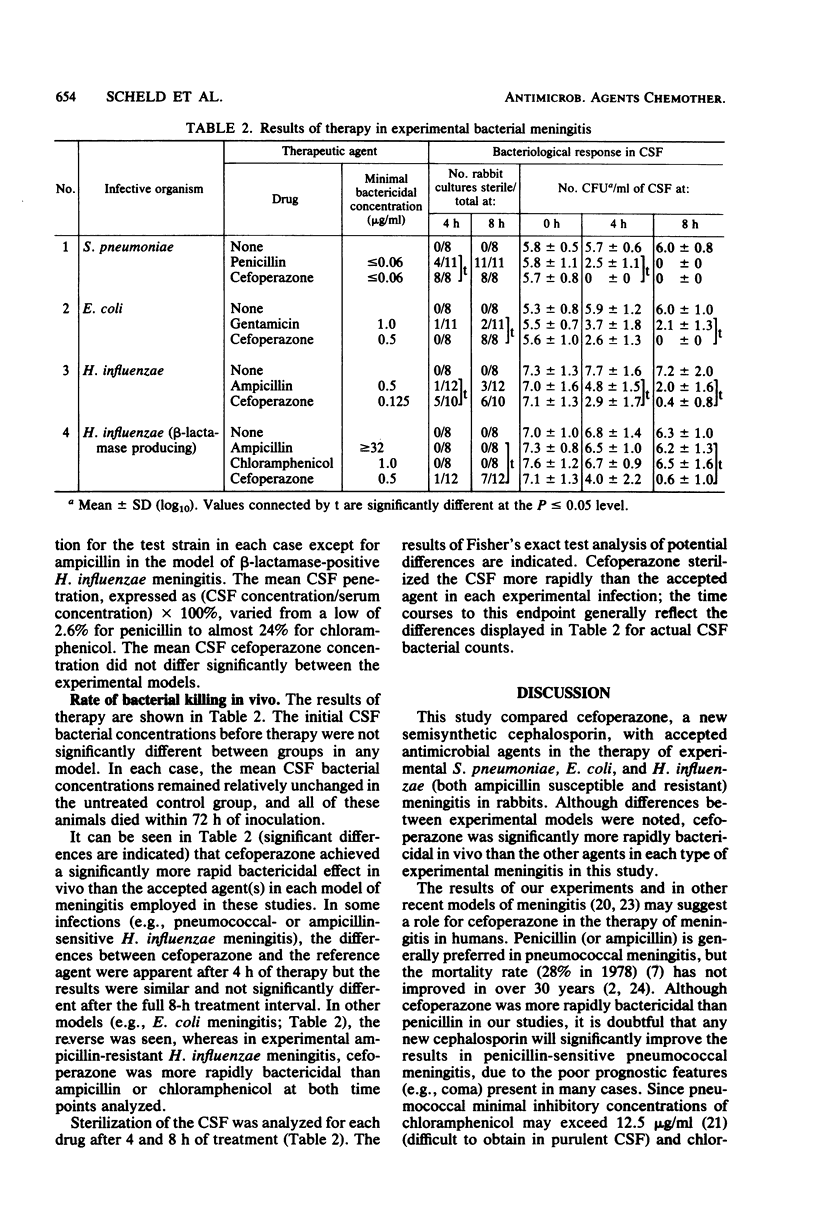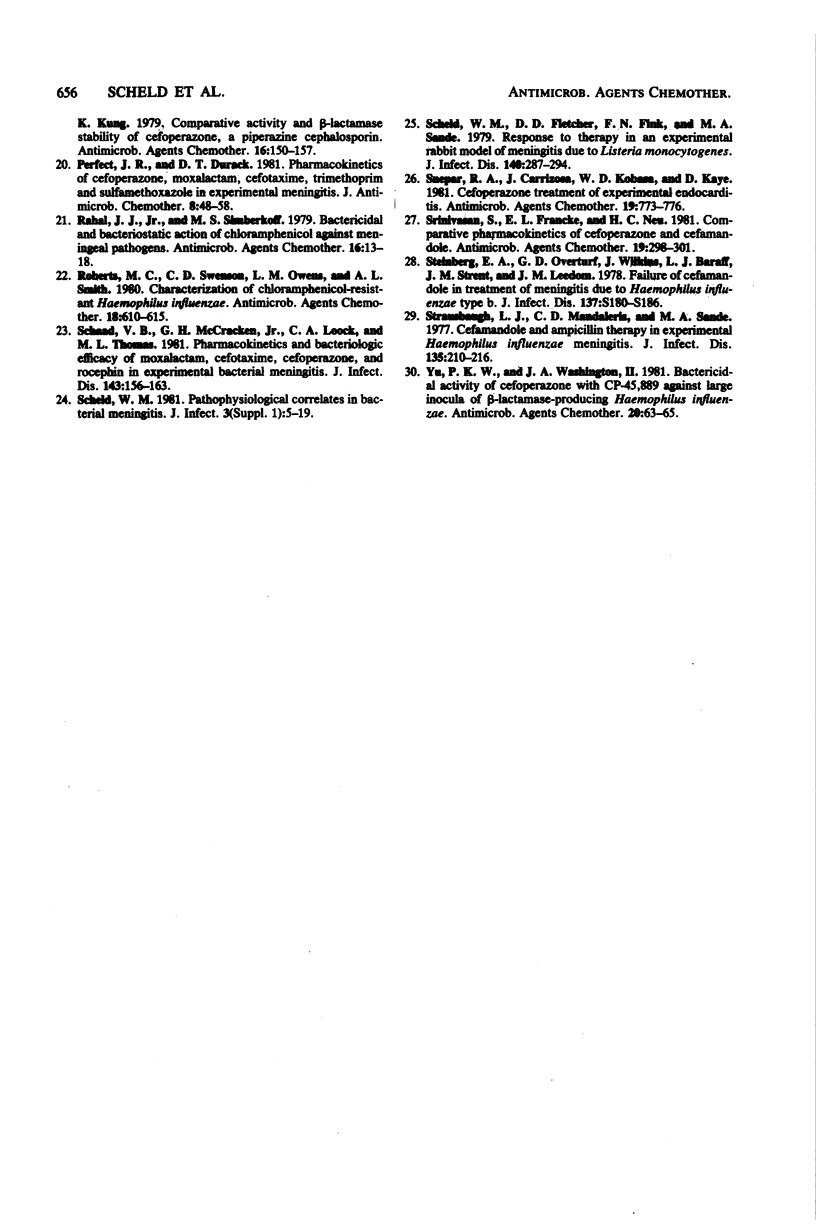Abstract
Cefoperazone was compared with penicillin against Streptococcus pneumoniae, gentamicin against Escherichia coli, and ampicillin and chloramphenicol against Haemophilus influenzae in the therapy of experimental meningitis in rabbits. Meningitis was produced by intracisternal inoculation into cerebrospinal fluid, and all antibiotics were administered intravenously over 8 h in dosages that would achieve serum levels comparable to those found in humans. The mean percent penetration into purulent cerebrospinal fluid, expressed as (cerebrospinal fluid concentration/serum concentration) x 100%, was 2.6% for penicillin, 22.0% for gentamicin, 12.1% for ampicillin, 23.8% for chloramphenicol, and 6.4% for cefoperazone. The mean cerebrospinal fluid antibiotic concentrations exceeded the minimum bactericidal concentration for the test strain in each experimental model, except for ampicillin in experimental meningitis due to the beta-lactamase-producing H. influenzae. Cefoperazone produced a significantly faster bactericidal effect after 4 h of treatment when compared with penicillin (P = 0.037) and ampicillin (P = 0.01) in meningitis caused by S. pneumoniae and H. influenzae (ampicillin susceptible), respectively. In meningitis caused by E. coli, cefoperazone was significantly (P = 0.006) more rapidly bactericidal after 8 h of treatment when compared to gentamicin. In addition, cefoperazone was significantly more rapidly bactericidal than either ampicillin or chloramphenicol in experimental meningitis due to beta-lactamase-producing H. influenzae. Cefoperazone deserves further evaluation in the therapy of bacterial meningitis in humans.
Full text
PDF




Selected References
These references are in PubMed. This may not be the complete list of references from this article.
- Alcid D. V., Seligman S. J. Simplified assay for gentamicin in the presence of other antibiotics. Antimicrob Agents Chemother. 1973 May;3(5):559–561. doi: 10.1128/aac.3.5.559. [DOI] [PMC free article] [PubMed] [Google Scholar]
- Baird D. R., Whittle H. C., Greenwood B. M. Mortality from pneumococcal meningitis. Lancet. 1976 Dec 18;2(7999):1344–1346. doi: 10.1016/s0140-6736(76)91985-1. [DOI] [PubMed] [Google Scholar]
- Baker C. N., Thornsberry C., Jones R. N. In vitro antimicrobial activity of cefoperazone, cefotaxime, moxalactam (LY127935), azlocillin, mezlocillin, and other beta-lactam antibiotics against Neisseria gonorrhoeae and Haemophilus influenzae, including beta-lactamase-producing strains. Antimicrob Agents Chemother. 1980 Apr;17(4):757–761. doi: 10.1128/aac.17.4.757. [DOI] [PMC free article] [PubMed] [Google Scholar]
- Bannatyne R. M., Cheung R. Chloramphenicol bioassay. Antimicrob Agents Chemother. 1979 Jul;16(1):43–45. doi: 10.1128/aac.16.1.43. [DOI] [PMC free article] [PubMed] [Google Scholar]
- Bergeron M. G., Claveau S., Simard P. Limited in vitro activity of cefamandole against 100 beta-lactamase- and non-beta-lactamase-producing Haemophilus influenzae strains: comparison of moxalactam, chloramphenicol, and ampicillin. Antimicrob Agents Chemother. 1981 Jan;19(1):101–105. doi: 10.1128/aac.19.1.101. [DOI] [PMC free article] [PubMed] [Google Scholar]
- Bolton W. K., Scheld W. M., Spyker D. A., Sande M. A. Pharmacokinetics of cefoperazone in normal volunteers and subjects with renal insufficiency. Antimicrob Agents Chemother. 1981 May;19(5):821–825. doi: 10.1128/aac.19.5.821. [DOI] [PMC free article] [PubMed] [Google Scholar]
- Corrado M. L., Landesman S. H., Cherubin C. E. Influence of inoculum size on activity of cefoperazone, cefotaxime, moxalactam, piperacillin, and N-formimidoyl thienamycin (MK0787) against Pseudomonas aeruginosa. Antimicrob Agents Chemother. 1980 Dec;18(6):893–896. doi: 10.1128/aac.18.6.893. [DOI] [PMC free article] [PubMed] [Google Scholar]
- Dacey R. G., Sande M. A. Effect of probenecid on cerebrospinal fluid concentrations of penicillin and cephalosporin derivatives. Antimicrob Agents Chemother. 1974 Oct;6(4):437–441. doi: 10.1128/aac.6.4.437. [DOI] [PMC free article] [PubMed] [Google Scholar]
- Fass R. J. In vitro activity of cefoperazone against nonfermenters and Aeromonas hydrophila. Antimicrob Agents Chemother. 1980 Sep;18(3):483–486. doi: 10.1128/aac.18.3.483. [DOI] [PMC free article] [PubMed] [Google Scholar]
- Feldman W. E. Concentrations of bacteria in cerebrospinal fluid of patients with bacterial meningitis. J Pediatr. 1976 Apr;88(4 Pt 1):549–552. doi: 10.1016/s0022-3476(76)80003-0. [DOI] [PubMed] [Google Scholar]
- Hall W. H., Opfer B. J., Gerding D. N. Comparative activities of the oxa-beta-lactam LY127935, cefotaxime, cefoperazone, cefamandole, and ticarcillin against multiply resistant gram-negative bacilli. Antimicrob Agents Chemother. 1980 Feb;17(2):273–279. doi: 10.1128/aac.17.2.273. [DOI] [PMC free article] [PubMed] [Google Scholar]
- Jacobs M. R., Koornhof H. J., Robins-Browne R. M., Stevenson C. M., Vermaak Z. A., Freiman I., Miller G. B., Witcomb M. A., Isaäcson M., Ward J. I. Emergence of multiply resistant pneumococci. N Engl J Med. 1978 Oct 5;299(14):735–740. doi: 10.1056/NEJM197810052991402. [DOI] [PubMed] [Google Scholar]
- Kaye D., Kobasa W., Kaye K. Susceptibilities of anaerobic bacteria to cefoperazone and other antibiotics. Antimicrob Agents Chemother. 1980 Jun;17(6):957–960. doi: 10.1128/aac.17.6.957. [DOI] [PMC free article] [PubMed] [Google Scholar]
- Lang S. D., Edwards D. J., Durack D. T. Comparison of cefoperazone, cefotaxime, and moxalactam (LY127935) against aerobic gram-negative bacilli. Antimicrob Agents Chemother. 1980 Mar;17(3):488–493. doi: 10.1128/aac.17.3.488. [DOI] [PMC free article] [PubMed] [Google Scholar]
- Matsubara N., Minami S., Muraoka T., Saikawa I., Mitsuhashi S. In vitro antibacterial activity of cefoperazone (T-1551), a new semisynthetic cephalosporin. Antimicrob Agents Chemother. 1979 Dec;16(6):731–735. doi: 10.1128/aac.16.6.731. [DOI] [PMC free article] [PubMed] [Google Scholar]
- McCracken G. H., Jr, Mize S. G. A controlled study of intrathecal antibiotic therapy in gram-negative enteric meningitis of infancy. Report of the neonatal meningitis cooperative study group. J Pediatr. 1976 Jul;89(1):66–72. doi: 10.1016/s0022-3476(76)80929-8. [DOI] [PubMed] [Google Scholar]
- McCracken G. H., Jr, Mize S. G., Threlkeld N. Intraventricular gentamicin therapy in gram-negative bacillary meningitis of infancy. Report of the Second Neonatal Meningitis Cooperative Study Group. Lancet. 1980 Apr 12;1(8172):787–791. [PubMed] [Google Scholar]
- Yu P. K., Washington J. A., 2nd Bactericidal activity of cefoperazone with CP-45,899 against large inocula of beta-lactamase-producing Haemophilus influenzae. Antimicrob Agents Chemother. 1981 Jul;20(1):63–65. doi: 10.1128/aac.20.1.63. [DOI] [PMC free article] [PubMed] [Google Scholar]


